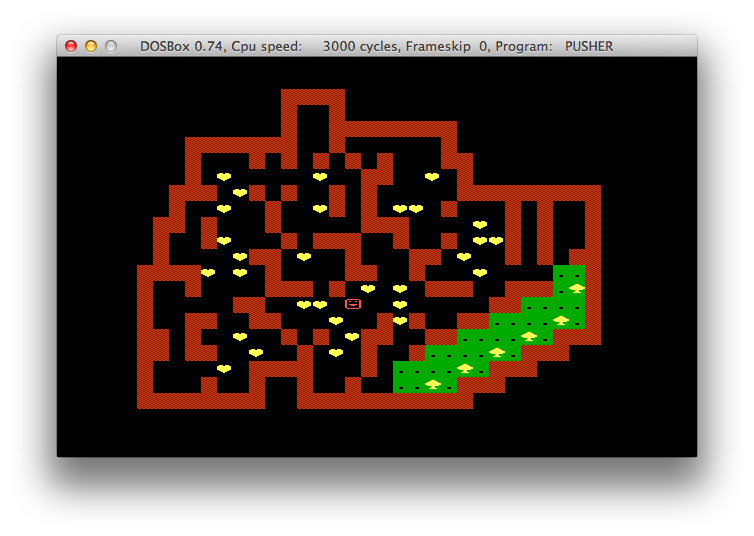Levels for Sokoban
At the times of XTs and DOS I loved playing Sokoban. The game I had was a tiny executable (less than 10Kb) for DOS called pusher.exe:

That was the first, simplest level, but how about this one?

The game perfectly works in DOSEmu: DOSEmu -exit pusher.exe.
Lazy people can checkout a quick video instead:
I was curious how 60 maps fitted into such a tiny executable. After a bit
of fiddling with IDA I wrote a simple program to extract the maps from the
pusher.exe binary and print them out. For example:
*************************************
Maze: 1
File offset: 148C, DS:00FC, table offset: 0000
Size X: 22
Size Y: 11
End: 14BD
Length: 50
XXXXX
X X
X* X
XXX *XXX
X * * X
XXX X XXX X XXXXXX
X X XXX XXXXXXX ..X
X * * ..X
XXXXX XXXX X@XXXX ..X
X XXX XXXXXX
XXXXXXXX
*************************************
All the map are available.
The maps are compressed with a Huffman-like approach using bit sequences of variable length. Each level has the following structure:
- map size X (1 byte)
- map size Y (1 byte)
- X*Y bytes of the map represented as a sequence of pairs <COUNTER><CODE>.
<COUNTER> is either a single 0 bit which means one repetition,
or four bits
1 D3 D2 D1, where the number of repetitionsN = 2 + D3*4 + D2*2 + D1(values 2 to 9). <CODE> has five different values: 00 - an empty space, 01 - a wall, 10 - a barrel, 101 - a place for the barrel, 111 - a barrel already in place. - Player’s start position X (1 byte)
- Player’s start position Y (1 byte)
And so for all 60 maps.
In the file pushermaps.c there is an implementation of the simple decompressor.
When disassembling the maps also had been presented in the convenient plain text form but still compressed.
level_01 db 16h, 0Bh, 0A2h, 0DFh, 38h, 32h, 1Fh, 38h, 2Ah, 3, 0E6h
db 12h, 0C0h, 0A5h, 0F2h, 83h, 2, 81h, 3, 0E4h, 12h, 82h
db 25h, 6, 0CDh, 64h, 22h, 51h, 0ACh, 11h, 0A1h, 0Ah, 5
db 0E5h, 11h, 0B1h, 14h, 82h, 29h, 82h, 31h, 0A0h, 0E1h
db 2Ch, 18h, 0D1h, 0CFh, 80h, 0Ch, 8
level_02 db 0Eh, 0Ah, 0F6h, 58h, 0Ch, 68h, 0Dh, 94h, 0C6h, 80h
db 85h, 2, 82h, 18h, 0D0h, 15h, 4Ch, 10h, 0C6h, 0C2h, 18h
db 21h, 8Dh, 1, 6, 4, 39h, 10h, 0A0h, 81h, 80h, 85h, 2
db 8, 20h, 60h, 34h, 1Bh, 0Ch, 1Eh, 0CAh, 7, 4
level_03 db 11h, 0Ah, 0E3h, 9Fh, 0Eh, 7, 0C2h, 11h, 42h, 1Fh, 8
db 50h, 23h, 0E0h, 85h, 4, 0Ch, 1Eh, 84h, 8, 0A6h, 0B4h
db 10h, 85h, 2, 82h, 59h, 0D4h, 28h, 14h, 90h, 0D6h, 83h
db 0DFh, 7Ch, 0Eh, 1
… etc.
So if you’d like to implement a quick and compact Sokoban for some reason, there is a bunch of already created and nicely compressed maps.
I know that there are tons of levels for Sokoban in the internet, plus automated Sokoban solvers and similar stuff. But it still doesn’t make all that fun of dissecting the twenty years old or more binary less interesting.
The project is available at GitHub’e – https://github.com/begoon/sokoban-maps.
Disclaimer